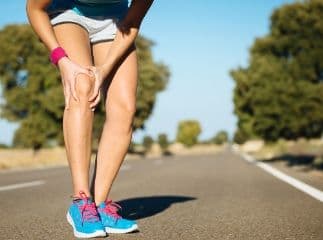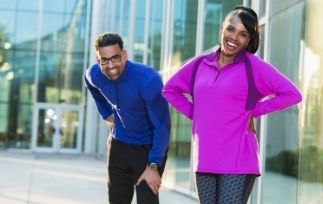Different workouts, different shoes…Agree? Well, all the training and running coaches will agree with me. However, if you are not a professional athlete and is into it only for fitness, then does it all make any sense? And if you are into something as closely related as walking and running, should you really use separate shoes for that…well let’s find out.
Are running shoes good for walking?
No, running shoes are not good for walking because running shoes have a bigger heel to toe drop, a flared heel, and a lesser range of motion. Walking shoes generally have low to zero-drop and have an undercut heel with more flexibility at the forefoot. They provide you with a better range of motion and better arch support. Also, they have lesser flexibility at the arch. Being said that, there are a lot of running shoes which you can easily use for walking as they have all the above characteristics.
Why am I making such a big fuss about walking and running shoes…well this is why…
Is there a difference between walking and running shoes?
Yes, there are a lot of differences between walking and running shoes:
- Walking shoes have undercut heels whereas running shoes have flared or big heels.
- Walking shoes allow your feet to naturally roll forward whereas running shoes don’t do that.
- Walking shoes don’t have much difference between the heel and the toes. Apart from zero-drop running shoes, most of them have a lot of heel to toe drop.
- Walking shoes have more flexibility at the forefoot than running shoes.
- Walking shoes are firmer at the arch than running shoes.
- Walking shoes have good arch support since you exert more force at the arch.
- Walking shoes are not as breathable as running shoes as your feet get way hotter during running.
- Walking shoes are meant to take up to 1.5 times your bodyweight whereas running shoes are meant to take force as high as 3 times your bodyweight.
Can you use running shoes for walking?
For example, these walking shoes for Brooks are exactly like their running shoes with only some minor differences in the upper and colors.
So in all, if you want to use a running shoe for walking, take the below things into consideration:
Will you solely be doing the walking?
This is one of the most important questions to answer.
If you are someone who has a walk/run routine, then a walking shoe may not be the proper choice.
Why?
As mentioned earlier, when you run you exert 3 times the force of your body weight.
However, when you walk, it is only 1.5. The targeted shoes are made accordingly.
So, if you will follow a run/walk routine, then you should use a running shoe instead of a walking shoe.
Are you a beginner runner?
Most beginner runners start off with walking.
However, they gradually make the full transition to running within 4 weeks.
If you are into this transition phase, you may not want to invest in a new pair of running shoes at the end of the 4th week.
If that is the case then stick to running shoes.
What is your style preference?
Running shoes will mostly come in lively, vibrant colors.
However, walking shoes sport more dull, boring colors.
There are people who love these colors and there are who absolutely hate them.
So, think whether the color choices will be a deciding factor for you or not.
Do your feet sweat a lot or easily stink?
There are few blessed individuals whose feet don’t stink no matter how much they sweat.
Again, there are some like me, who with minimal maintenance can get away with it.
However, there are some less fortunate ones, whose feet become stinky easily.
If you are one of those, you may want to avoid walking shoes altogether.
Why?
Most of the walking shoes don’t have so much breathability as their upper are not generally constructed with mesh.
However, this also makes the inner shoe environment hotter and make your feet sweat more.
If your feet sweat a lot or they easily stink, then you will be uncomfortable wearing these shoes.
So, stick to a running shoe with good breathability and you will be fine.
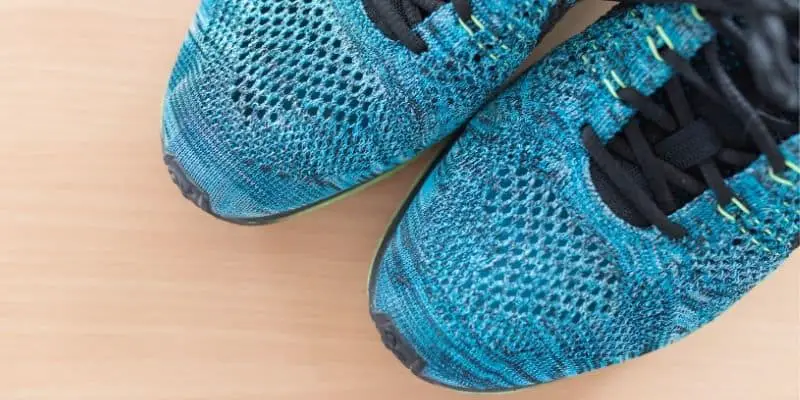
Is cost an issue?
A different shoe for a different purpose.
Ideally, this is how it should be. However, practically speaking this is not the case.
Our budget constraints us all and athletic shoes are expensive.
So, if you don’t mind the cost, go for a separate pair of shoes for different types of workouts.
However, if not, try to select an athletic shoe for both purposes.
The key features of a walking shoe are:
- Lesser heel-to-toe drop
- Lesser cushioning.
- Good flexibility at the forefoot
- Lesser flexibility at the arch.
- Undercut heel.
- Pronation
- Width of the shoe
- Any special feet requirements
- Arch Type
If any running shoe can match these features, then it is fit for walking.
Don’t worry, I’ll explain all the details later.
Most of the time, you will find these features in zero-drop and minimalist running shoes.
Why?
These shoes are made to provide you with a more natural running experience.
Their soles are typically thinner and for a minimalist shoe, this will be around 3-4 mm, [yes you read it right…millimeter].
So, you will be using your foot’s natural dynamics which coincides with the aim of your running shoes as well.
Another, kind of running shoe will also serve you well as a walking shoe. They are the “five fingers”.
These shoes are designed to give you a barefoot experience. Hence, they will also support all your walking needs.
Also, these minimalist runners are not only cheaper by almost 75%.
They are durable which makes your walking/running gear investment near to NIL.
Cost, durability, etc. have their own places. However, what matters most is, whether your shoe will support your pronation.
Although, you might be aware, however, here is a quick recap for those who are unfamiliar with this term.
Pronation
Pronation is the way your feet roll once it hits the ground.
There are three types of pronation:
Overpronation Or Pronation – When your feet touch the ground, if it rolls inwards, you have overpronation.
Depending on how much it rolls, it can be categorized from low to severe pronation.
Also, these people may frequently have other issues like flat feet or bunions which again calls for a bit different type of shoe.
Neutral – Here there is little to no rolling of your feet when it hits the ground.
These runners will mostly suffer fewer injuries during their entire running/walking career.
Underpronation Or Supination – This is where your feet roll outward when it hits the ground.
Depending on how much rolling is happening, it may be low to severe underpronation.
Again, many times underpronation people have high arches and less flexible ankle joints. Their shoes have more cushioning at the heels to compensate for this inflexibility.
A picture is equivalent to a thousand words:

Once you know what kind of pronation you have, pick up a shoe that will support your kind of pronation.
In running shoes, you will typically have 5 main types of shoes:
Neutral – As the name suggests, it is meant for runners with neutral pronation. However, if you have a low to medium underpronation, these shoes will serve you as well.
Supination – Again, these shoes are meant for runners who tend to supinate. These shoes will restrict this rolling and will keep your feet in a neutral position.
Guidance – These are meant for runners with mild overpronation. They will guide your feet lightly and will correct the foot to a neutral position.
Stability – These running shoes are meant for runners with low to medium overpronation. These shoes will typically have more padding in the collar and the tongue. This way they will keep your ankles stable and don’t let them roll as much.
Motion Control – If you have severe overpronation, then motion-controlled shoes are the only ones that can help you. They control the in-shoe rolling using various technologies like the rolling bar, etc, and keeps your inward rolling motion in check.
However, they are typically heavier than other shoes due to these additional features.
Here is a quick recap…
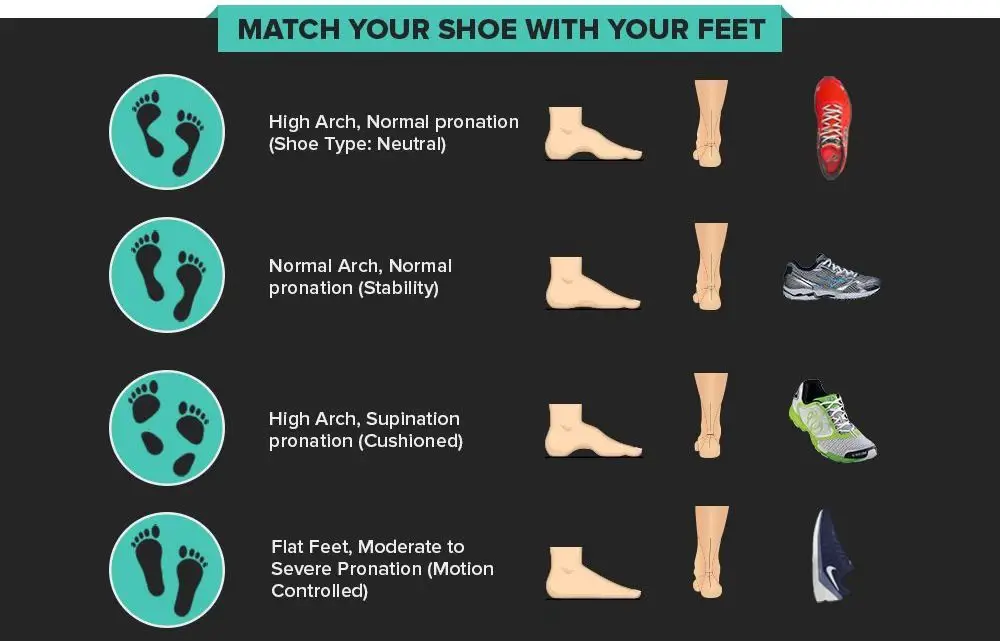
Since the chances of injuries are less in walking, walking shoes typically come in fewer variants:
Neutral – They are suited for neutral walkers and underpronators.
Stability – For walkers with low to medium overpronation.
Motion control – This is for walkers with severe overpronators.
Width of the foot
Why I’m specifically bringing up the width of the foot?
Well, it is very important. Duh!
If you wear a narrower shoe than your feet, you will develop unnecessary pains and aches.
Also, you will start to weaken your feet muscles.
In certain situations, due to special conditions, the width of your feet changes.
How?
Let’s say, you have a bunion or a tailor’s bunion.
In both cases, they are a bony bump on one of the sides of your feet
This will effectively increase the width of your feet and you may have to select shoes specifically made for bunions or tailor’s bunion.
Why?
Because the width of your feet is equivalent to the widest part of your feet. In your case that includes the total width including bunions.
So, you may have to go-up the width chart for a better fit.
For example, if you have a wide foot, you may have to select a pair with 2E or extra wide.
How to find out your fit?
- Take a measuring tape.
- Measure the widest part of your feet.
- Now match the obtained number with the below pictures.
- You will get your proper fit.
Here we have provided the fit for men and women individually so that you can get your perfect fit.
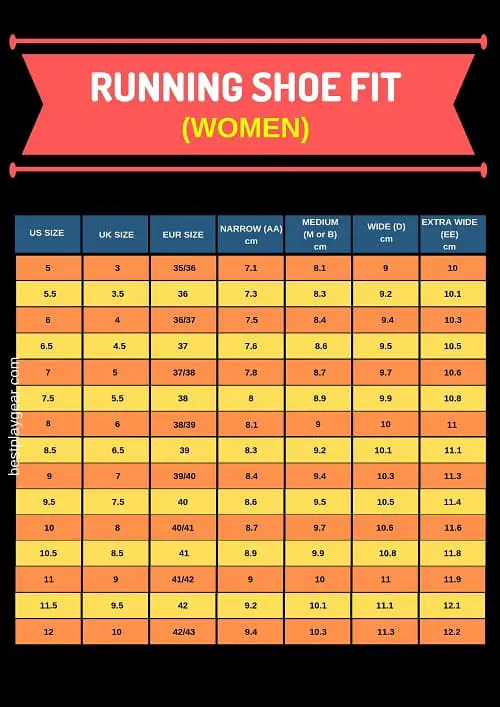

Any special requirements
As we go through life and through our fitness journey, we gradually pick up certain injuries.
And they sometimes tend to stick on and cause more issues if not dealt with properly.
However, if you want to walk with such injuries, you better get some specialized shoes.
Here is a couple of them that may help you out:
Arch Type
Other than the above criteria for selection, your arch type will also play a significant role in your shoe selection.
Foot arch can be divided into three main categories:
Flat to low arch – Here, your entire sole of the feet will touch the ground.
These runners are more prone to overpronation and plantar fasciitis.
This feet condition you may be born with, or you may develop at a later stage of life.
At that time, it is called a fallen arch and you may typically develop it due to hormonal imbalance or pregnancy.
Normal arch – Here you have a well-formed arch and your feet function as expected.
High arch – Here you have an overly developed arch where only your balls of the feet, toes, and heels touch the ground.
The below picture will help you to understand this better:

You may be thinking of how to find out your arch type…
Well, it is very easy…all you have to do is water imprint test.
Steps:
- Pour some water on your feet.
- Stand on a colored paper when they are still wet.
- Match the imprint with the above image.
- You will get a conclusive answer or your arch type.
Related Questions
Should I be buying different shoes for different purposes?
Ideally, you should.
However, practically speaking, that may not be possible for many reasons.
For example,
It may ruin your budget – This is my primary concern. Since running shoes cost more, I tend to look for a multipurpose shoe.
Especially, I don’t use a separate walking shoe. I know, I know…I’m a miser that way. However, I’ve recently switched to a new shoe and am loving it. Also, I use it for both running and walking and till now did not face any issue.
You may be a frequent traveler – For some people, the cost may not be an issue however, space may be. If you are a frequent traveler then you can stuff only so much in your luggage. So, it is practically impossible to carry 3-4 pairs of shoes only for fitness.
Also, these shoes take up more space anyway. In such cases, a multipurpose shoe is what you need.
You don’t like athletic shoes – Yes, I know one of my friends who hates running shoes or shoes for that matter. He says, mother earth has created us this way and we are only restricting the freedom of our feet by wearing shoes. He prefers to roam around in open sandals and barefoot.
Well, that is extreme, but you may not like shoes and my friend has a valid point anyway. Your feet become strongest when your workout barefoot. However, there are other dangers like getting cut by some sharp object or accidentally stepping on some oh so nice things ;).
So, I feel that those Five Fingers are a happy compromise. They’re close enough to barefoot walking/running and will keep you protected from those unhappy encounters :D.
What are the best running shoes for walking?
Any running shoe having all the features mentioned above are great for walking.
If you are specifically looking for shoe names, here are the best running shoes for walking:
I hope this helps…

Should you use running shoes for walking? What are the health hazards you may have to deal with? What you should do instead? Which running shoes can be used for walking? All of these questions are answered…

Madhusree Basu
Author, Admin
Blogger and a fitness enthusiast. She loves running and Yoga and everything in between. She started running to manage her weight and to eat to her heart’s content. A true foodie at heart she shares whatever knowledge she has gained throughout the years about weight management and fitness.
References
https://www.dignityhealth.org/articles/the-difference-between-running-shoes-and-walking-shoes
Martin, PHILIP E., and D. W. Morgan. “Biomechanical considerations for economical walking and running.” Medicine and Science in Sports and Exercise 24.4 (1992): 467-474.
Kerrigan, D. C., Franz, J. R., Keenan, G. S., Dicharry, J., Della Croce, U., & Wilder, R. P. (2009). The effect of running shoes on lower extremity joint torques. Pm&r, 1(12), 1058-1063.
Roca-Dols, Andrea, Marta Elena Losa-Iglesias, Rubén Sánchez-Gómez, Ricardo Becerro-de-Bengoa-Vallejo, Daniel López-López, David Rodríguez-Sanz, Eva María Martínez-Jiménez, and César Calvo-Lobo. “Effect of the cushioning running shoes in ground contact time of phases of gait.” Journal of the mechanical behavior of biomedical materials 88 (2018): 196-200.
Hamill, J., Bates, B.T. and Knutzen, K.M., 1984. Ground reaction force symmetry during walking and running. Research Quarterly for Exercise and Sport, 55(3), pp.289-293.
Morio C, Lake MJ, Gueguen N, Rao G, Baly L. The influence of footwear on foot motion during walking and running. Journal of biomechanics. 2009 Sep 18;42(13):2081-8.
Wearing, S., Reed, L., Hooper, S., Bartold, S., Smeathers, J. and Brauner, T., 2014. Running shoes increase Achilles tendon load in walking: an acoustic propagation study. Medicine and science in sports and exercise, 46(8), pp.1604-1609.






